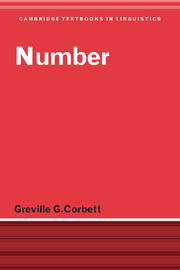Book contents
- Frontmatter
- Contents
- List of figures
- List of tables
- Preface
- List of abbreviations
- 1 Introduction
- 2 Meaning distinctions
- 3 Items involved in the nominal number system
- 4 Integrating number values and the Animacy Hierarchy
- 5 The expression of number
- 6 The syntax of number
- 7 Other uses of number
- 8 Verbal number
- 9 Conclusion and new challenges
- References
- Author index
- Language index
- Subject index
9 - Conclusion and new challenges
Published online by Cambridge University Press: 05 June 2012
- Frontmatter
- Contents
- List of figures
- List of tables
- Preface
- List of abbreviations
- 1 Introduction
- 2 Meaning distinctions
- 3 Items involved in the nominal number system
- 4 Integrating number values and the Animacy Hierarchy
- 5 The expression of number
- 6 The syntax of number
- 7 Other uses of number
- 8 Verbal number
- 9 Conclusion and new challenges
- References
- Author index
- Language index
- Subject index
Summary
We will review briefly the route we have taken, and then draw out some threads which have run through the book, mainly in order to consider future prospects. We started by identifying all the number values we could find, whichever type of nominal showed them (chapter 2). Then we kept the values still and looked at the different types of nominal involved in the simplest singular–plural systems. We established that their distributions were constrained by the Animacy Hierarchy (chapter 3). Next we put the possible systems of number values together with the hierarchy and found that this typology covered a great deal of the data and the variation, but had to be elaborated to account for phenomena such as conflated number (chapter 4). Then we turned to the means of expression of number, and again found great diversity (chapter 5). The initially daunting difficulties of agreement in number were made manageable, once we drew a clear distinction between controller and target number (chapter 6). In chapter 7 we examined the ‘other’ uses of number, which are many and varied, and found that they too begin to fit into a typology. And then in chapter 8 we turned to verbal number, showing how different it is from nominal number and examining why.
While we have been able to make considerable progress, it is clear that there are many aspects still to be better understood.
- Type
- Chapter
- Information
- Number , pp. 265 - 298Publisher: Cambridge University PressPrint publication year: 2000



